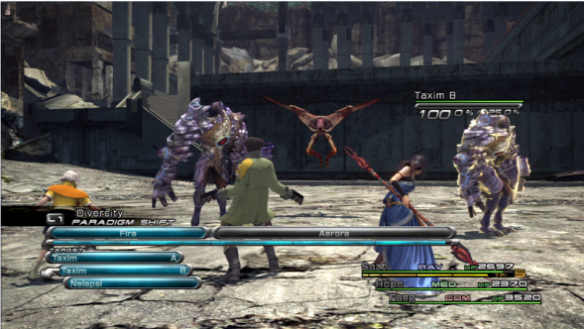第7世代のJRPGを定義する7つのポイント
During the 6th generation of consoles, J-RPGs (in the boadest sense) changed a lot : random encounters practically disappeared, dialog became voiced, maps became more linear (with the notable disappearance of the World map), cutscenes skippable and Action-RPGs flourished. The 7th generation offered examples of defining new features and trends that show the genre still evolves probably more that it’s given credit for. Let’s have a look at the few, simple, features that are becoming the new “norm” in 7th gen japan-made RPGs.
1. Auto-heal
Do you enjoy spending 30 seconds in your menu after each combat to use 8 potions on each of your three team members ? Do you feel that dying because you forgot to heal before the Boss enhances gameplay ? If so, you might not like the new “auto-heal” trend, but for the rest of us, that’s less busywork, more fun !
Best examples: FF XIII, Xenoblade, Resonance of Fate.
2. Talking while fighting
In a J-RPG, there is a lot of information to convey on the story and characters. You could do it while having a long drive a la Red Seeds Profile (Deadly Premonition) or during the most random of encounters, like Vashyron, Zephyr and Leanne… But nothing beats being introduced to a talking book while battling two possessed statues.

Best examples: Nier, Resonance of Fate, FF XIII.
3. No random rare drops (or at least much much less…)
Does fighting the same boss over and over until he finally drops his ultimate weapon sounds like even more fun than selecting your potions from your menu ? The idea of making drops dependent of your success in battle (like FF XIII) or of what part of the enemy you destroy (a la Dark Souls) is much more fun, challenging and less mindlessly time-consuming. We have yet to see an RPG where all rare drops are replaced by skill dependent drops, but the trend is at least in the right direction.

Best example : Demon’s souls, Dark souls, FF XIII, The World Ends With You.
4. “Suspend” or “Quick save” anywhere
Asking every game to boast a “save anywhere” feature (like a certain webzine notorious for its questionable lists) is a not such a brilliant idea, as the positioning of a game’s checkpoints are part of basic gameplay mechanics, and we don’t want all games to play the same. What works for Xenoblade might not work for Dark Souls. However, there is nothing to lose by offering players, in every RPG, an opportunity to “suspend” or, in the portable world “quick save”, their game when they want to quit : just delete the save when you boot back.

Best example : Demon’s souls, Dark souls,Dragon Quest IX, Resonance of Fate.
5. No more Game Over, and the “restart combat” option
Speaking of “saving”, Dragon Quest pioneered this long ago but the game over screen that asks you to reload your game seems outdated now. In the 7th generation, more and more RPGs auto-save your progress, let you restart from the beginning of the combat, and/or make death/K.O. a part of the gameplay mechanics. It’s smoother, more varied, and lets minor encounters be more interesting.

Best example : Souls games, Atelier games, FF XIII, Resonance of Fate.
6. Original voices
6th gen J-RPGs were criticized for their bad voice acting. In the 7th generation, gamers expect to have a choice between original voice overs and English voice overs. Even if you don’t have room on the 50 gig blu-ray, you can still make an Asia version with English subtitles like FF XIII, XIII-2 and hopefully Versus XIII ? Can’t you, Atlus ?

Best examples : Every Tri-Ace game, every NIS game, Xenoblade, Final Fantasy, Lost Odyssey, and much more… come one ATLUS, why not you ?
7. More challenge
J-RPGs of the 6th generation were pretty easy – with the notable exception of Grandia Extreme and the SMT games. These last three years, things have changed in the RPG world. Without even mentioning the challenge of the Souls games, Final Fantasy managed to make each encounter challenging (except of course if you don’t understand how it plays), plus Final Fantasy XIII presented boss fights unheard of Square’s PS2 era titles. Resonance of Fate‘s battle system was so difficult to grasp that many mistook it for a grindfest – when then probably didn’t get how precise and unforgiving the strategic gun combat was – especially compared to Valkyrie Profile 2 that was pretty straighforward. Radiant Historia is harder than Radiata Stories, Xenoblade more intense than Xenosaga, and even Atelier Totori is way more difficult than previous GUST titles.

Best example : About anything that came out since 2009 and doesn’t star a White Knight.
That’s it ! These are the most defining features I see in the most recent 7th gen RPGs. Of course, one could have talked about the grand return of the World Map (Arc Rise Fantasia, Ni No Kuni, Versus XIII), the integrated online (WKC) and so on. Is there any other new trend in J-RPGs that I might have missed ?


your list was like… Weaksauce. Most of it is standard for every 7th generation game anyway.
Maybe that’s the whole point 😉
Anyway, thanks for your comment.
No rare drops in Demon’s Souls… Pure Bladestone say hi!
Hi ! And thanks for your comment !
Yes there are still rare drops in Demon’s souls (even Dark Souls) but as I state in the article there are much less of these drops than in previous gen games of this type (like Phantasy Star Online or Monster Hunter). For instance, Boss’s souls are used to forge weapons or have a spell and they are 100% drop – which would never have been the case in those previous gen games.